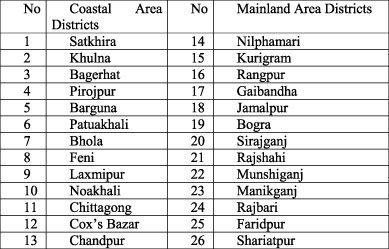
Bangladesh ranked fifth among 10 countries most vulnerable to the climate change-induced natural disasters in the last two decades from 1993 to 2012, according to a report. During the period, Bangladesh suffered damages worth US$ 1,832.70 million, caused by 242 types of natural catastrophes, mentions the Climate Risk Index (CRI), 2014. A looming crisis is there: about 20 million people in Bangladesh may be displaced by the sea level rise alone over the next 40 years. A range of alternative predictions say Bangladesh may lose 15 per cent of its landmass and over 35 million people in 19 districts can be displaced in the event of the sea level rise by one metre in this century and that more than 200 million people may be displaced permanently from their traditional habitats due to cyclone, tidal surge and river bank erosion couple with a high level of saline water intrusion. Moreover, approximately 63 million and 78 million people may be displaced in 2015 and 2020 respectively.
Of the 19 coastal districts in Bangladesh, 12 are directly exposed to cyclones and tidal surges. Since 1970, 26 major cyclones hit Bangladesh, with 18 of them occurring in the last 20 years. About 19 million people were affected then. Riverbank erosion displaces 50-200 thousand people each year. It is predicted that 17 per cent of the coastal area may be inundated by 2050, if global warming cannot be reduced. In that case the migration scenario may worsen.
According to the recent report on 'Climate Displacement in Bangladesh' prepared by the Displacement Solutions and the Young Power in Social Action, of the 64 districts in Bangladesh, 26 coastal and mainland districts are already witnessing climate-induced displacement. The districts that have records of displacement in are listed below:
It is interesting to note that none of the policies or action plans deals with the issue of migration. Migration as an adaptive option has not been thought of by the policy makers as well as development practitioners. The National Adaptation Programme of Action (NAPA) and the Bangladesh Climate Change Strategy and Action Plan (BCCSAP) are concerned about building capacity and resilience against climate change effects through localisation of problems. It is found that migration of family members at the time of distress provides the much-needed economic support to the households.
In the case of Bangladesh, both internal and international labour migration plays an important role in the development process. Each year 400,000-500,000 Bangladeshis officially migrate abroad as contract workers. The number of internal migrants is assumed to be more than double the international migrants. Besides, it has a diaspora population of 1.5 million. In 2010, they sent $ 11.6 billion in remittances. Migrants' remittances are 12 times more than the Foreign Direct Investments (FDI) and six times more than Overseas Development Assistance (ODA).
However, there is currently no comprehensive mechanism to provide support and ensure rights of climate-displaced people. Bangladesh has adopted a number of laws, policies, strategies and institutional frameworks relevant to climate displacement. But there is no clear indication how population displacement problems will be addressed. In addition, there are no detailed action plans with a timeframe to tackle this problem.
To face the challenge of mass displacement (both internal and external) as a result of climate change, the Young Power in Social Action (YPSA) has been implementing the Bangladesh Housing, Land and Property (HLP) rights initiative with the support of the Displacement Solutions (DS) for better settlement of climate-displaced people since 2012. The main objective of this project is to identify rights-based solutions and actions that could be undertaken to resolve the displacement of these climate-affected communities as well as to ensure and safeguard their housing, land and property rights.
For strengthening the advocacy campaign on solving the crisis for climate-displaced people the YPSA recently developed 5 key actions as follows:
1. Climate displacement monitoring mechanism should be implemented across Bangladesh
2. The rights of climate-displaced persons should be incorporated into the existing climate change law and policy
3. Distribution of government Khas land should be effective, transparent and just and the needs of climate-displaced people should be taken into account.
4. Non-agricultural Khas land should be allocated for climate displaced people.
5. Effective return, relocation and rehabilitation programmes should be implemented for all climate displaced persons
Bangladesh has signed and is bound to respect many key international human rights treaties that provide important human rights protections to climate-displaced people. These include:
* The International Covenant on Economic, Social and Cultural Rights Bangladesh acceded in 1998;
* The International Covenant on Civil and Political Rights (Bangladesh acceded on 6 September 2000);
* The Convention on Elimination of All Forms of Discrimination against Women (Bangladesh acceded on 6 November 1984); and
* The Convention on Rights of the Child (Bangladesh ratified on 3 August 1990).
Further, although non-binding, Bangladesh is bound to respect the UN Guiding Principles on Internal Displacement as they reflect and are consistent with international human rights and humanitarian laws.
The following seven steps could be taken by the government and national, regional and international stakeholders in order to devise a truly effective and coordinated response to climate displacement in Bangladesh:
-Undertake a comprehensive review of existing national laws and policies
-Design and implement rights-based national laws and policies
-Undertake a review and re-design of the existing institutional framework
-Design and implement domestic land solutions
-Increase coordination and knowledge sharing among international and regional donors
-Create an UN and NGO working group on climate displacement
-Improve coordination and communication between the government and the civil society.
Prabal Barua is research officer and Md Shahjahan is the team leader at the Young Power in Social Action (YPSA) prabalims@gmail.com ypsa.hlp12@gmail.com
© 2025 - All Rights with The Financial Express
